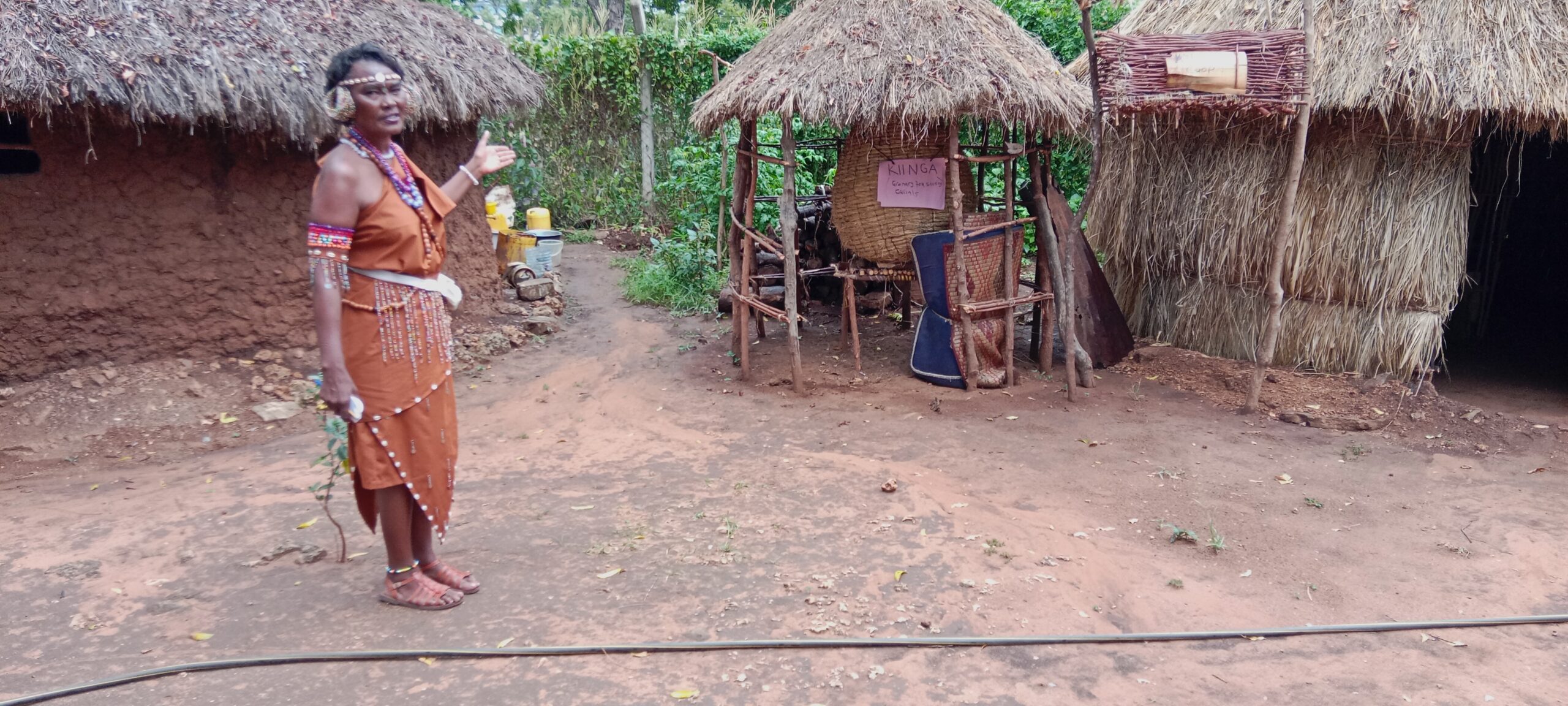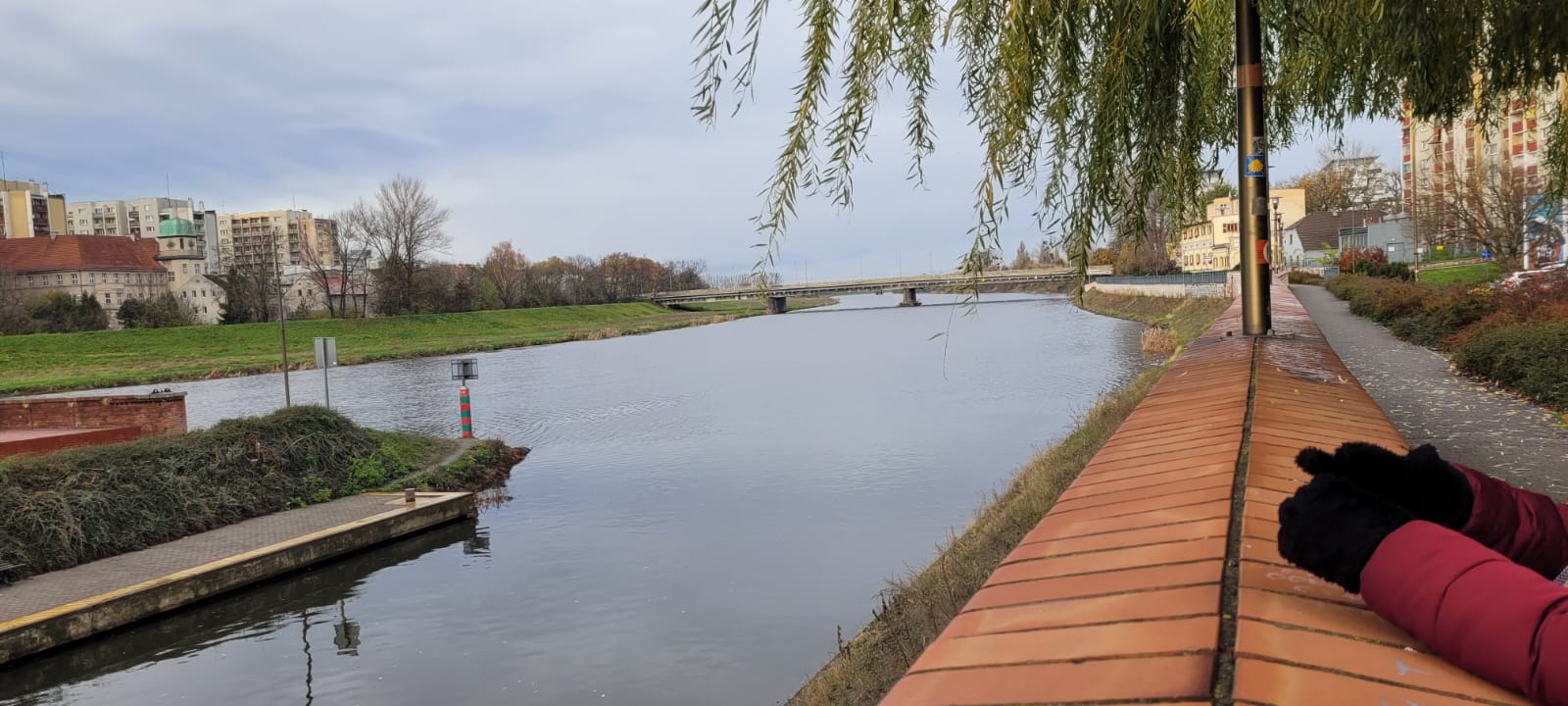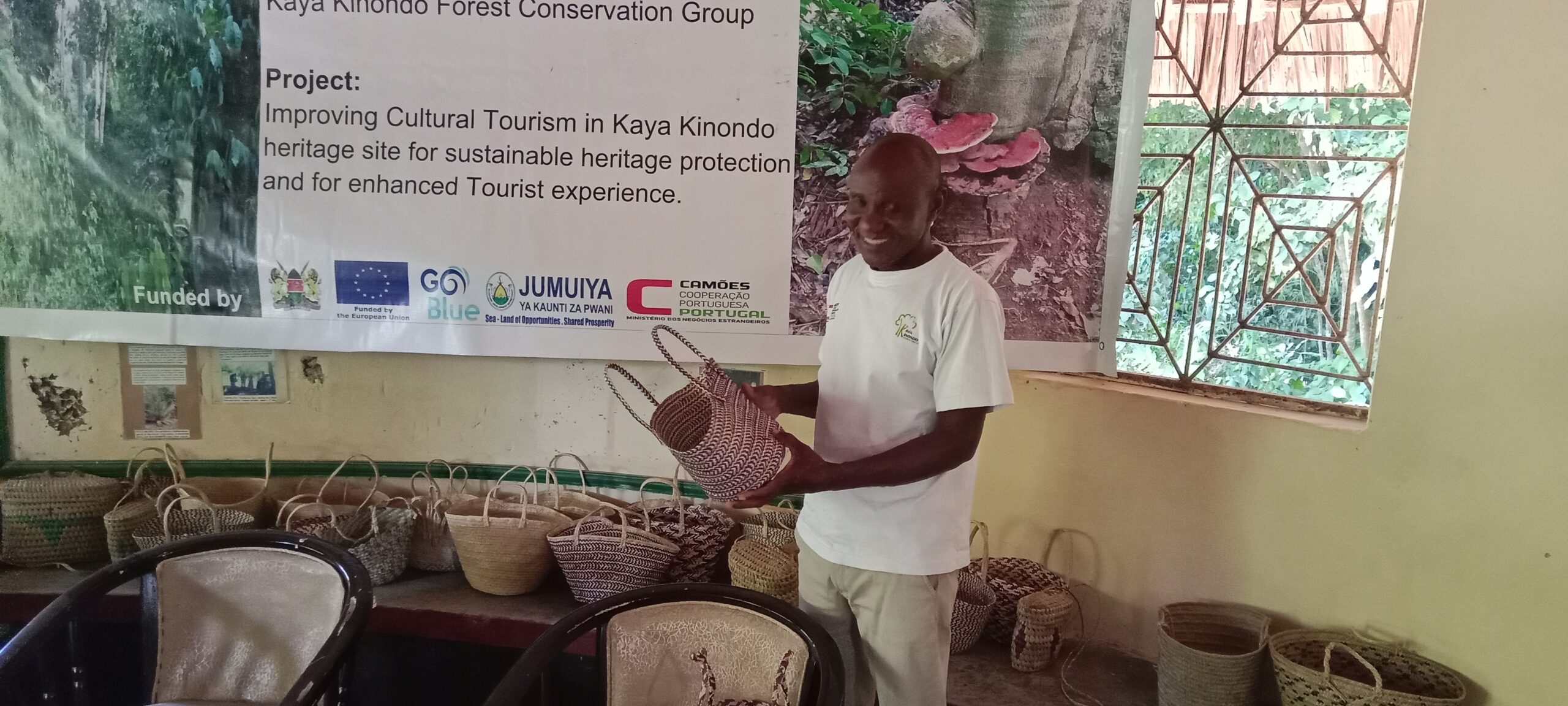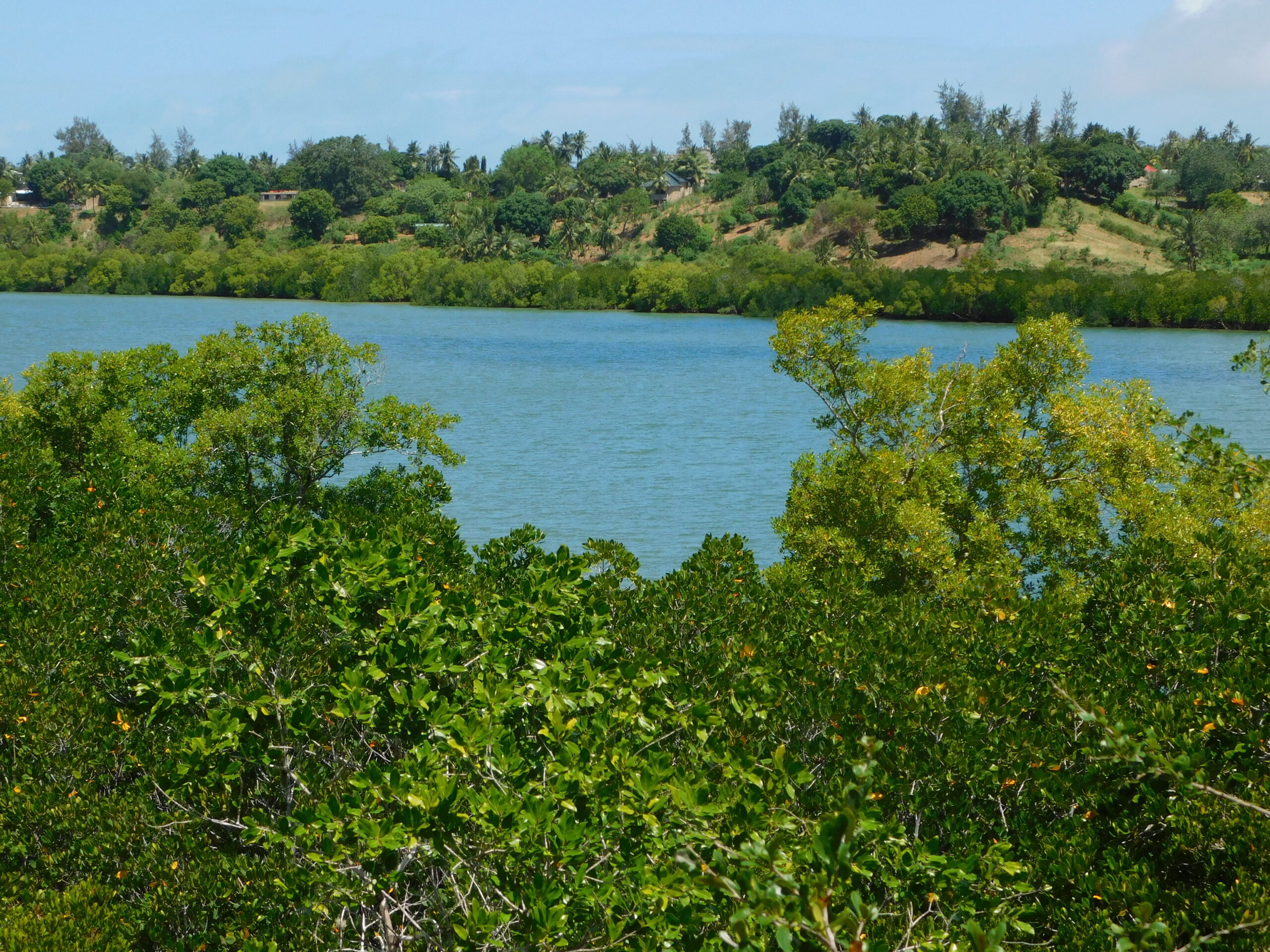Joyce Ndung’u at the Cultural village gives us a tour of the traditional homesteads. Photo Credit Mazera Ndurya.
A walk in to the Mombasa Cultural Village inside the Mkomani Showground conjures up a feeling of village life, one that is complete with the frills of tradition.
It is a testament of how diverse cultures can be blended into a rich tourism product, drawing local and international visitors.
Today, Joyce Ndung’u, a fashion designer and traditional dance enthusiast, who rallied other artists looks back with pleasure at what their efforts have brought forth, a product that has attracted funding from the Go Blue Project of the European Union and the Kenyan government.
The Go Blue Tourism and Cultural Heritage Component Action was funded by Camões, I.P., a Portuguese organization. In collaboration with the Jumuiya ya Kaunti za Pwani Economic Development Secretariat, a partnership between the EU and the Kenyan government, the initiative was designed to mitigate the negative effects of COVID-19 on global tourism, with a focus on both recovery and growth of the sector.
With a grant of Ksh 300,000, sub-granted by The Mombasa Tourism Innovation Lab, a programme of the SwahiliPot Hub, under the Tourism and Cultural Heritage component of the Go Blue project—funded by Camões IP with Sustainable Travel & Tourism Africa providing technical assistance (STTA), the group was able to revamp the cultural village.
Today, the village, a vibrant center for cultural preservation, education, and tourism, serves as a testament to Joyce’s passion for traditional dance and her commitment to empowering her community.
The Mombasa Cultural Village is an offshoot of the Mombasa Cultural Dancers’ Association, a group that, under Joyce’s leadership, united traditional dancers across the region to advocate for fair welfare. Their efforts paid off—soon, every time they performed, they were paid for their art.
However, like many others, their activities were severely impacted by the COVID-19 pandemic. Social distancing restrictions meant their performances came to a halt, and many dancers, particularly younger members, left the group in search of other sources of income.
After the pandemic subsided, the group mostly women regrouped and conceived the idea of building a cultural village to preserve and promote traditional dances.
In 2022, they officially opened the Mombasa Cultural Village in the Mkomani area, located inside the Agricultural Society of Kenya grounds. The village now serves as a living museum, where visitors can experience the cultural practices of 11 Kenyan tribes, including the Luo, Maasai, Kikuyu, Mijikenda and Swahili communities, among others.
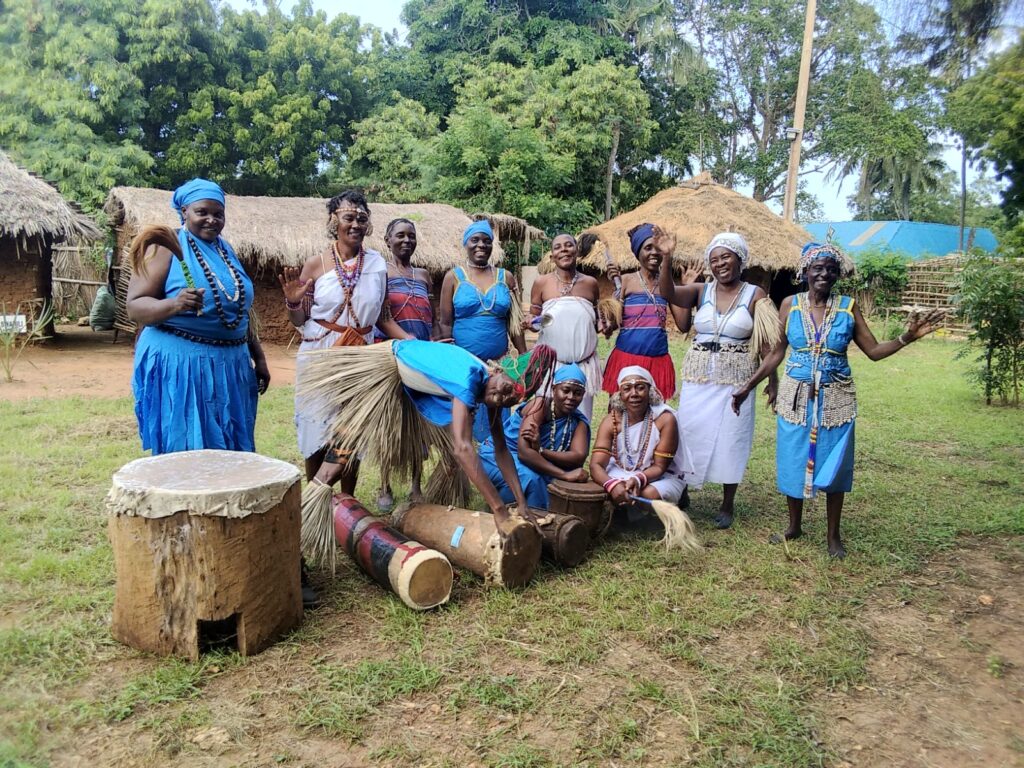
“As this village grows, we are creating job opportunities not only for women but also for the youth. Some are working in arts and crafts, while others will be hired for office roles to handle our business paperwork and bring in new ideas, especially on how to market ourselves digitally,” Joyce said.
Initially, the village was self-funded. Joyce and her group of 42 active members, all over 40 years old, pooled their savings to buy the space and start building traditional houses. They would meet three times a week, each contributing Ksh100 to buy materials like posts. They built each house while cooking and eating together, fostering a sense of unity and cohesion.
The village opened to the public in March 2022. While the opening drew large crowds, they soon faced challenges. Visitor numbers dwindled, and they struggled to attract tourists with their limited resources. In 2023, just as they were about to give up, they discovered the Mombasa Innovation Lab, which had advertised a grant to support youth working in tourism, culture, and heritage.
Although they were not the target age group, Joyce said they took a bold step and applied for the grant.
“We applied, and by God’s grace we qualified, and were given Ksh300,000,” said Joyce. “The grant helped us develop a website, social media platforms, brochures, and fliers that helped us gain more visibility.”
Half of the grant was also used to renovate the roofs of some houses that had started leaking, and to purchase artifacts they didn’t have.
Now, the group is receiving visitors from schools as well as local and international tourists, with some bookings coming through their newly developed website. They have hosted guests from Australia, America, Germany, France, Japan, and many other countries, including repeat visitors.
They welcome over 100 visitors per month. School students are charged Ksh200, college students Ksh250, Kenyan adults Ksh500, and children Ksh 250. Visitors from East Africa pay Ksh1,000 for adults and Ksh500 for children, while non-residents are charged Ksh 2,000 for adults and Ksh1,000 for children.
The package includes a traditional dance performance from various communities, followed by a tour of the homesteads where guests are shown how different communities lived in the past and how they used various artifacts. The entire tour lasts roughly 1 hour 30 minutes to 2 hours.
They also offer other services, such as traditional cooking experiences, where a guest can pay Ksh4,000 to cook a traditional meal with the community of their choice, with the fee covering the cost of ingredients.
Some young mothers who were part of the group initially left due to the lack of income, as they were hoping to make money to support themselves. However, many have now returned and are creating bracelets and necklaces, which they sell to visitors through the village’s gift shop.
Joyce noted that the visitors, especially the youth, have shown a deep appreciation for the culture and a genuine curiosity about how communities lived in the past.

Peter Kibe, the Hospitality and Tourism Pathway Lead for the Global Youth Opportunity Network initiative at Swahilipot Hub in Mombasa, focuses on identifying tourism opportunities for the youth in the region. “Mombasa, like the rest of the country, is struggling with youth unemployment. This requires us to explore all sectors, invest, and innovate to create opportunities for young people,” he said.
In response to this challenge, the Mombasa Tourism Innovation Lab was established. Kibe said Mombasa was losing market share to neighboring countries by relying too heavily on its coastal beaches, so there was a need for new products to revitalize the coastal tourism sector.
“We wanted to create innovative tourism products to attract more visitors. Trends show that today’s traveler isn’t the pensioner who just wants to relax at the beach. Modern tourists want to experience culture and immerse themselves in village life. That’s what we set out to develop,” Kibe explained.
He added, “We sought grassroots ideas where people could also turn their livelihoods into tourism products. By doing so, tourists would have a broader range of activities, stay longer, and return for repeat visits.”
With these ideas in mind, they applied for the Camões IP grant and pitched their proposal. After securing 50,000 euros, they issued a call for proposals and selected grassroots initiatives to sub-grant. Mombasa Cultural Village was one of the beneficiaries. “Kenya has a diverse culture, and the way the women were able to showcase different cultural aspects in the village made it a strong initiative to attract tourists,” Kibe noted.

Other sub-grantees included Studio BelaBela, a creative art space focused on enhancing art experiences, and Umoja wa Pwani, a local group from Changamwe area, which worked to revive Swahili cultural heritage and develop local gastronomy experiences. This group also held cultural events at the Swahili Center. African Food Trail, another grantee, is a food tour run by young Swahili women, taking visitors through the city to experience local food like mahamri and viazi karai while appreciating historical sites.
Key Lens, a media and photography company, was supported to help grow village tourism by encouraging photographers to capture and share images of local tourism products online. Big Ship, a conservation group, was aided in developing an eco-tourism tour along the mangroves, called the Mikoko Nature Trail, where locals are employed to guide visitors, earning an income in the process.
“We also taught these groups how to market themselves digitally, which has helped increase tourist traffic. Many businesses have seen an increase in visitors and are earning a steady income,” Kibe shared.
However, Kibe acknowledged challenges in the tourism sector, noting that much of it has developed by default, with limited government support compared to sectors like agriculture.
“We need to shift our thinking. If we’re considering livelihoods, we should see tourism as a viable driver of economic growth. While it’s important to develop agriculture and other sectors, tourism also has immense potential to improve livelihoods”, he concluded.
Judy Gona is the team lead at Sustainable Travel and Tourism Africa (STTA), a Pan-African organization at the forefront of shaping a sustainable future for Africa’s tourism. With over 18 years of experience as a sustainable tourism expert, STTA provided technical assistance to Camões, the Portuguese development agency, which was one of the partners in the Go Blue project.
She said one of the key goals of the program was to support innovative projects and businesses that would create new employment opportunities, contribute to the diversification of tourism products, and influence the dynamics of the tourism value chain within the Jumuiya ya Kaunti za Pwani economic block.
“When people think of tourism, the first things that come to mind are the sandy beaches of the coast and the Big Five animals,” Judy said, adding that this perspective needs to change by introducing new, innovative products that incorporate culture.
“It would be a completely different landscape if the counties implement some of the recommendations identified in the blueprint. If communities are inspired, we can expect a complete shift in how culture and heritage are perceived, presented, promoted, and interpreted for the market,” she concluded.

Future Plans
Joyce is determined to elevate the Mombasa Cultural Village to new heights, seeking additional funding to secure permanent structures and expand the representation of different communities within the village.
“Most of the visitors who come here ask if they can spend the night,” Joyce explained. “They desire a full experience — to sleep here, shower here, cook here, and taste the local food, so we want to build permanent rooms and offer an accommodation package”, she said.
She also hopes to start training and educating young people, with elders teaching traditional customs, such as how boys were once initiated into adulthood and women passing on life values to young girls.
Peter Kibe emphasized the ongoing need for support in the tourism sector.
“We are committed to ensuring that this program continues,” he said. “The Camões funding was a catalyst that has demonstrated the need for such initiatives. We will keep championing for continued support and innovation in tourism.”
A tourism expert Dr Sam Ikwae is in agreement on the need to look at the cultural heritage tourism differently through innovations that would fully harness this segment of the industry.
Dr Ikwae who is the coast region coordinator of the Kenya Association of Hotel Keepers and Caterers (KAHC) said the coast region is a melting pot of culture and heritage with diverse communities that have unique cultures.
“The coast region is fully cosmopolitan teaming with people from different cultural backgrounds. Even with that the indigenous communities from the region including the Mijikenda through their sacred forests called kaya, cuisines and dressing have a lot of offer.
Although funding is key in realizing this huge potential, Dr Ikwae says there is need to give the industry policy directions, come up with innovative ways of marketing the product to ensure sustainability.

